1. Private Tombs in the Theban Necropolis

Since 1980, excavations and cleanings of the private tombs of the New Kingdom have been carried out in the Theban Necropolis. Until 1989, TT241 at al-Khokha, TT128 (1980-1983), TT129, TT317, TT318 at Shaikh Abd al-Qurna (1982-1986) and TT333 have been investigated.
Together with the excavations, some comparative studies of the private tombs have been undertaken in the Theban Necropolis. Since 1984, a number of tombs belonging to the late Eighteenth Dynasty, from the reign of Thutmose IV to Horemheb, have been visited, in order to understand the original designs of the mural paintings at “Kom al-Samak” at Malqata South.
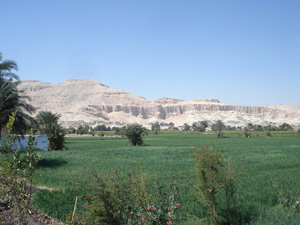
Theban Necropolis |
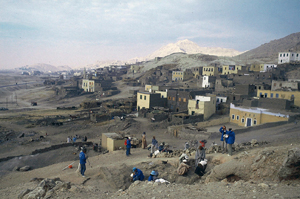
Works at Dra Abu al-Naga
|
2. Previous works (1980-1989)

<al-Khokha>
TT241
The work at TT241 at al-Khokha started with the aim of conducting a comparative study of the Eighteenth Dynasty wall paintings, fragment of which were found by Waseda University at Kom al-Samak at Malqata South. TT241 was chosen for the first study. The goals were to examine wall paintings and to investigate the structural remains. TT241 (tomb of Ahmose) is located on the east hillside of al-Khokha. A.W. Shorter has already published the inscriptions in this tomb. The existence of the inner chamber belonging to the ealier period became clear through the cleaning of the floor of the hall. This tomb was tentatively named W-1. From the survey of this W-1, TT241 and TT184, which is connected to the south of the former tombs, the chronological order or their constructions became clear. At first the tomb W-1 was built. When TT241 was built in the reign of Tuthmose III, the ceiling of the inner chamber of the tomb W-1 seems to have been destroyed in the course of building the entrance part of the tomb TT241. Then the inner chamber was filled with sand, and the stone steps were made at the entrance of the tomb TT241, at the place where the tomb W-1 existed. Later during the reign of Ramesses II, the tomb W-1 seems to have been reused by Nefermenu (TT184). The time of the construction of the tomb W-1 is not known. The painted relief of "Ankh" could be seen in the niche of the inner chamber of the W-1. The floor of the inner chamber of TT 241 had been completely destroyed then excavated, and another tomb TT48, which exists under the tomb TT241, could be seen through this hole.
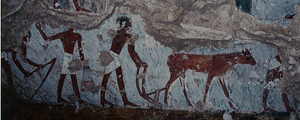
Agricultural scene in TT241 |
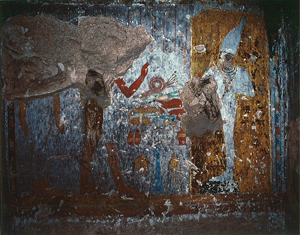
The tomb owner adoring Osiris in TT241 |
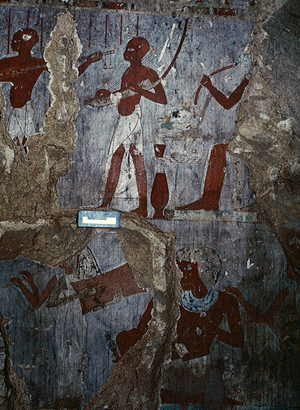
Musicians in TT241 |
<Shaikh Abd al-Qurna>
Excavations were carried out for four seasons: in December 1982, from December 1983 to January 1984, from December 1984 to January 1985 and from December 1985 to January 1986. First of all, the sand which had covered the forecourt of TT128 and TT129 was removed in order to enter TT318, as the only way to get into the tombs was through the iron door of TT129. TT318 is connected with TT129 by a small tunnel which might have been made by tomb robbers. A number of tombs are connected with each other in a complex way. While removing the sand from the forecourt, an unregistered tomb was discovered in the east side, which was tentatively named W-2. This room has a shaft in the north room, and there are two rooms under the shaft. A variety of interesting finds were discovered from the excavation of the tomb W-2. No reliefs or inscriptions were found inside the tomb.
TT128 and TT129
W. Schenkel has already reported TT128 and TT129. TT128 belongs to the Saite period and it was built making use of tomb TT129 built in the 18th Dynasty of the New Kingdom. The tombs' interiors were checked by referring to Schenkel's report. However, the paintings and reliefs on the ceiling and walls are not well preserved, and the figure of the Goddess Nut which was reported to be painted on the ceiling could not be detected. The tombs were surveyed and charted on paper. A part of the floor in the hall was excavated, and it was discovered that the floor had been covered with sand and rubble to a depth of approximately 50 cm.
TT317
At the beginning of the survey, the sand covering the hall of TT317 was removed. It became clear that this tomb was built by having destroyed and older, smaller tomb. There were no reliefs or inscriptions in the inner chamber. There was a shaft with a depth of 3.5 m, and under the shaft there were two rooms. A great number of mummies and human bones were excavated from the hall and the rooms under the inner chamber. The ceiling is covered with soot and it is hard to see the paintings clearly. However, they were photographed and also sketched.
TT318
Four statues in the inner room which were mentioned by scholars of the last century have completely disappeared. It seems that they have been taken away by tomb robbers. However, the condition of the paintings on the walls and the ceiling was rather good. The outer lintel and jambs of the inner room together make the form of a gate. Inscriptions are carved and painted on them. Here the name of Amen has been deliberately erased.
Physical Anthropological Studies
A great number of mummies and human bones were found in the tombs. They were examined and measured using physical anthropological method. Valuable data on the ancient Egyptian mummification process were obtained through these examinations.
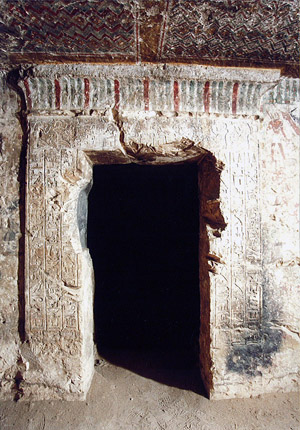
Entrance from the hall to the inner chamber of TT318 |
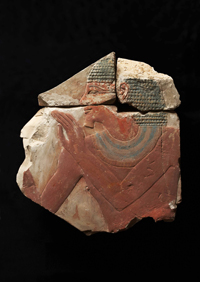
Painted relief fragments from TT318
|
<Dra Abu al-Naga>
Excavations at Dra Abu al-Naga were carried out over five seasons, from December 1987 to September 1989. It was our original intention to begin work by clearing TT333 on the south slope of a hill called the Pyramid of al-Mandara. It has long been completely buried under the ground. During the first season (December 1987), TT 333 was rediscovered.
TT333
The hall ceiling of TT333 is completely lost. Most of the wall paintings of the hall and the inner room had suffered serious damage. A number of fragments of painting were found lying on the floor of the inner room. The white plastered forecourt of TT333 were recovered outside the entrance during our excavation.
W-4, W-5, and W-6
In March 1988, an unregistered tomb was found at the location only 5 meters to the north west of TT333. This, we called W-4 for the time being. The hall ceiling is lost, and it has neither painting nor inscriptions inside. Sandstone columns with the name of the Overseer of works, Amen-em-wia, were uncovered in the forecourt. It was presumed that W-4 was originally an 18th Dynasty tomb, re-used in the Ramesside period.
Following this discovery, we decided to excavate and clear the area to the west of TT333. Two other unregistered tombs (W-5 and W-6) were discovered in 1988 and 1989. Both had suffered serious damage. The south wall of the hall of W-5 bore ritual scenes in front of mummies, which are standing in front of the entrance of a tomb with a pyramidion on top of it. Most of the wall-paintings inside W-6 are lost, although on the west wall of its hall there are the remains of a fowling scene, heavily covered with soot. High quality fragments of painting were also found lying on the floor of its hall. From the remains of the wall paintings, it was concluded that W-5 and W-6 are the long-lost tombs A 21 and A 24. This area of the necropolis has also yielded a variety of isolated objects, including funerary cones, shabtis, stamped mud bricks and a stone statuette.
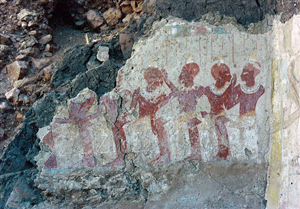
Wall Paintings from the hall of TT333
|
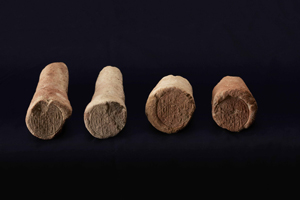
Funerary cones from TT333
|
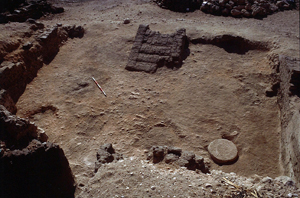
The forecourt of W-4 (Kampp -127-)
|
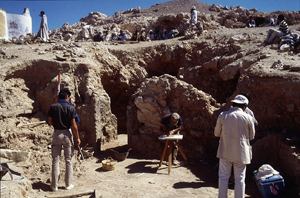
Wort at the forecout of W-4 (Kampp -127-)
|
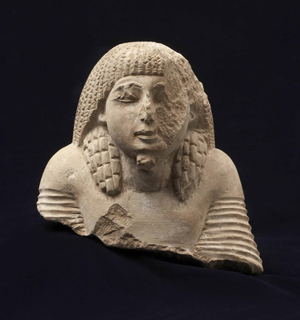
Upper part of a painted limestone statue |
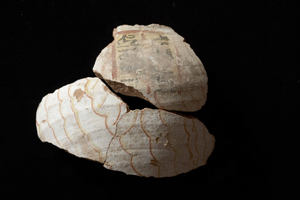
Imitation pottery of stone vessel |
3. Current Project at al-Khokha

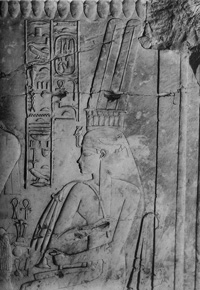
Relief of Tiye (Carter 1903 pl.II) |
TT47 (Tomb of Userhat) and its vicinity
Initial clearance of TT47 was carried out in 1902-1903 by the “Omda” of al-Qurna village under the supervision of the Department of Antiquities. Howard Carter, who later discovered Tutankhamun’s tomb in the Valley of the Kings, reported on the work of the tomb by the Omda in Annales du Service des Antiquités de l’Égypte, vol. 4 with the photograph of the beautiful relief figure of Queen Tiye, the principal wife of Amenhotep III, carved on the wall inside the tomb. A fragment of this image of Queen Tiye was later cut by plunder and finally brought to Musée royaux d’Art et d’Histoire in Brussels where the piece is exhibited. The last report concerning TT47 was described in 1908 by Arthur Weigall. Since then, the exact location of TT47 had been lost. It was until 100 years later when TT 47 was rediscovered by the Japanese mission from Waseda University.
We started working in el-Khokha area in December, 2007, after modern village houses were torn down due to the removal of the Qurna village to the north. The mission cleaned a huge depression and identified the edge of the courtyard with full of debris probably belonging to TT47. Clearance of the western part of the courtyard in the 2008-2009 season exposed the lintel with the name and title of the tomb owner: “Overseer of King’s Private Apartment, Userhat.” The lintel measures approximately 2.8 m in width. Both the upper part and lower part is extensively broken. Thus, the remaining height measures approximately 60 cm. The decoration of the lintel shows very high quality of relief carvings from the time of Amenhotep III, consisting of two scenes: on the right, Userhat worshipps the god Atum and a goddess either Hathor or the Western goddess, while one the left there are images of Ra-Horakhty and Maat and the figure of Userhat on this side is missing. In the center of the lintel, the nomen and prenomen of Amenhotep III is inscribed under the sun disk. The motif of the lintel parallels to that of the tomb of Kheruef (TT192), Overseer of the house of Queen Tiye, contemporary to Amenhotep III’s reign. In the 2009-2010 season, we found two door jambs with the vertical columns of Hetep-di-nesut formulae and the seated figures of Userhat at the bottom of the door jambs.The mission expects to reveal more portions of the tomb of Userhat (TT47) in the future seasons.
Along with the clearance of TT47, we have been conducting epigraphic documentation, architectural research, and conservation works at TT174, Tomb -62-, TT264, and Tomb-330- in our concession area.
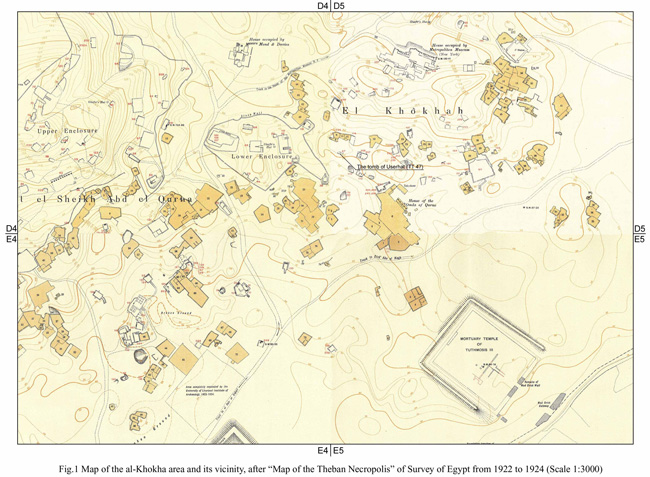
Site map of Al-Khokha
|
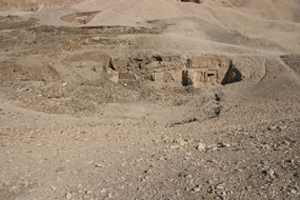
TT47 before clearance (from south) |
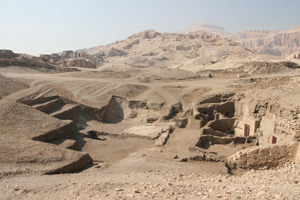
TT47 and neighbor tombs |
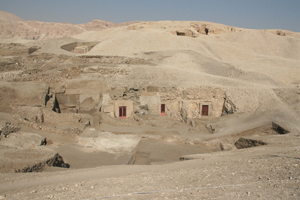
TT47 after clearance (from south) |
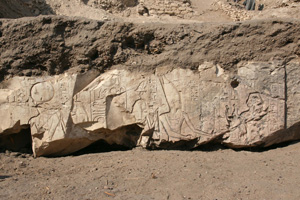
Relief on the lintel of TT47
|
4. Bibliography

- Carter, H. 1903 “Report of work done in upper Egypt (1902-1903)”, Annales du Service des Antiquites de l’Egypte 4, pp.171-180.
- Eigner, D. 1983 “Das Thebanische Grab des Amenhotep, Wesir von Unteragypten: Die Arkitektur”, Mitteilungen der Deutschen Archaologischen Instituts Abteilung Kairo 39, pp39-50.
- Kampp, F. 1862 Die Thebanische Nekropole, Zum Wandel des Grabgedankens von der XVIII. bis zur XX. Dynastie, Theben 13,2 vols., Mainz am Rhein.
- Porter, B. and Moss, R.L.B. 1960 Topographical Bibliography of Ancient Egyptian Hieroglyphic Texts, Reliefs, and Paintings, I: The Theban Necropolis, Part 1: Private Tombs, Oxford.
- van de Walle, B., Limme, L. and De Meulenaere, H. 1980 La collection egyptienne, Les etapes marquantes de son developpement, Bruxelles.
|



